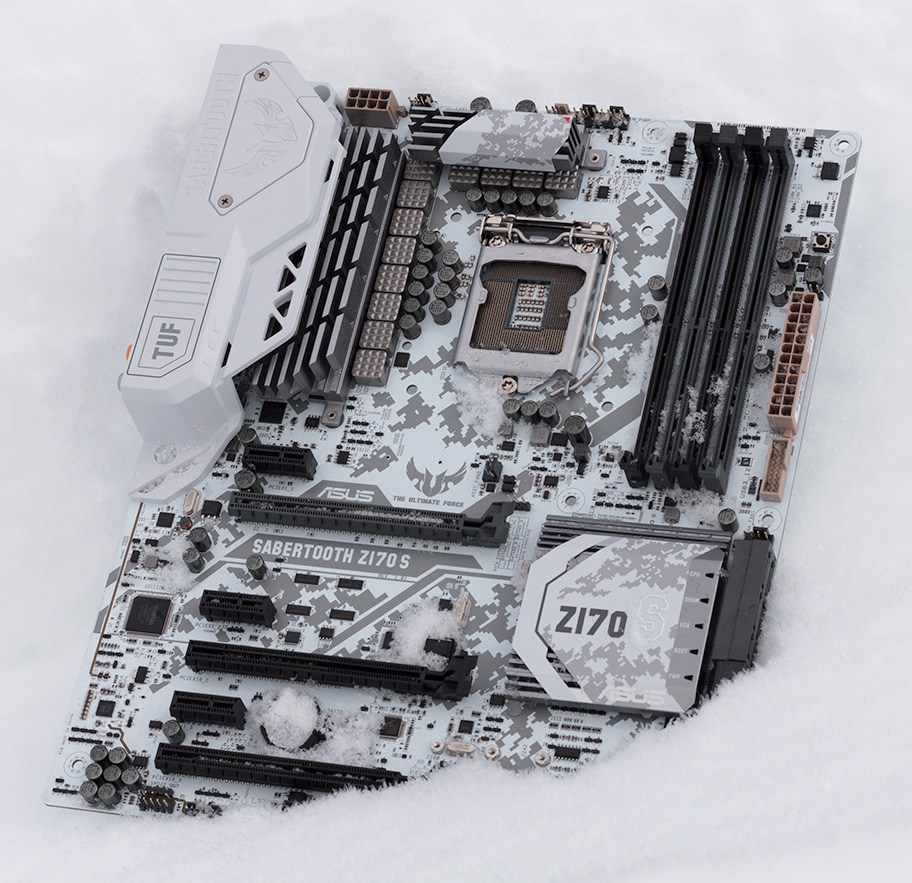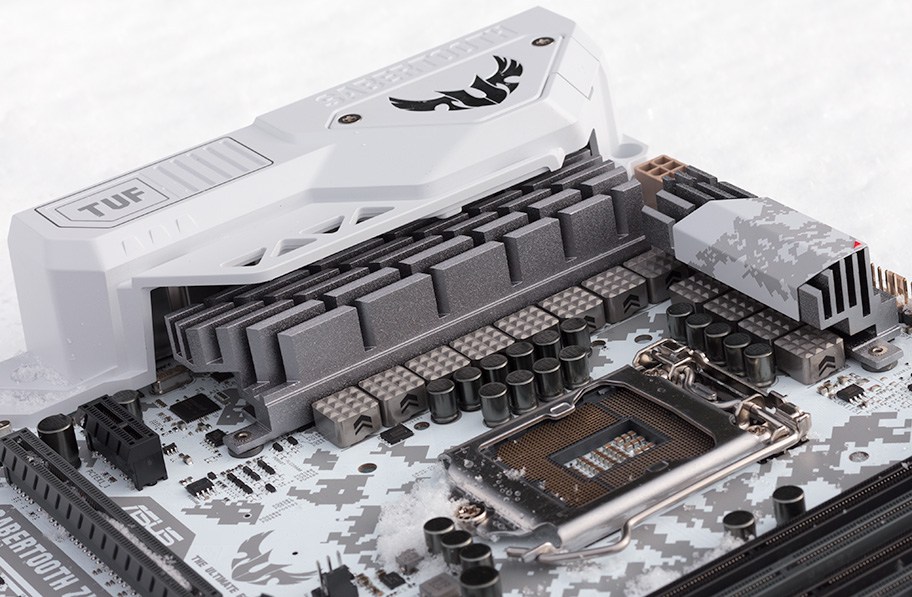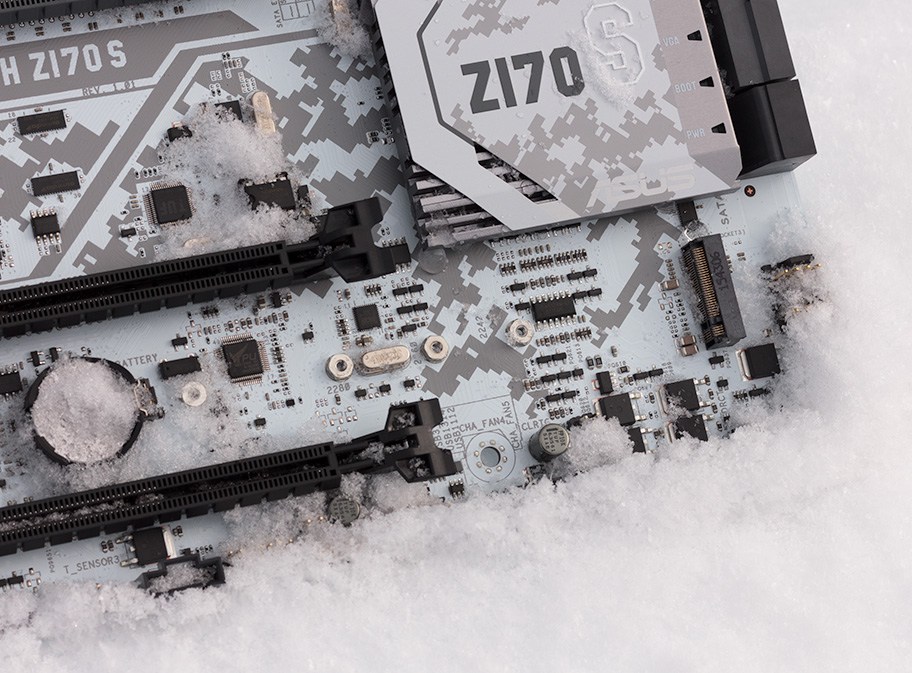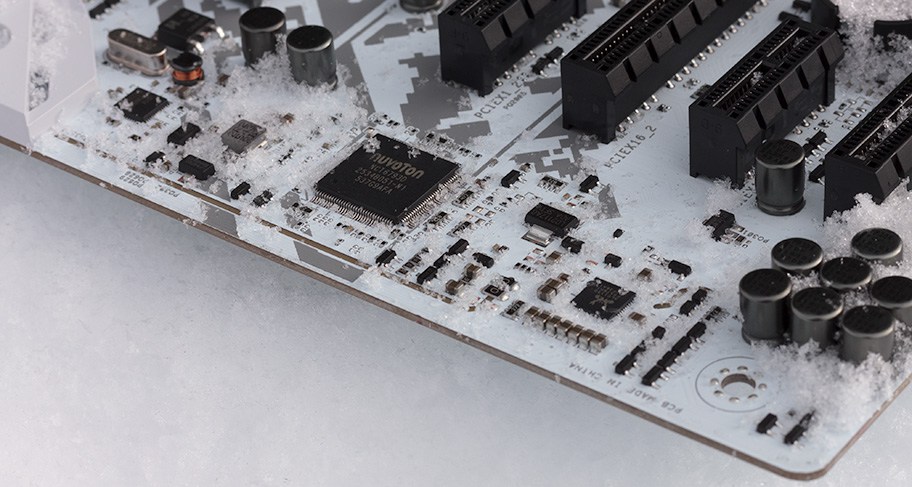Asus Sabertooth Z170 S Motherboard: Winter Is Coming Inside Your PC
Asus has released its Sabertooth Z170 S motherboard, which we first saw during CES. This motherboard is somewhat similar to the Sabertooth Z170 Mark 1 released last year in terms of specs, but it loses some of the more advanced cooling features, and it gains a unique winter camo theme.
Although it falls short of the Sabertooth Z170 Mark 1 in terms of features, the Sabertooth Z170 S is still a fairly high-end motherboard. It should still perform well when overclocking processors thanks to its well-developed digital power design that uses numerous power phases.
The motherboard is clearly targeted at gamers, and it supports multi-GPU configurations up to quad-SLI and quad-Crossfire. The first two PCI-E x16 slots are configured to connect to the CPUs, but oddly enough Asus opted to connect PCI-E x16_3 to the chipset's PCI-E controller instead, which may result in lower overall performance because of increased latency and a potential bottleneck issue. PCI-E x16_3 also shares one of the system’s HSIO lanes with one of the SATA ports, and if that SATA port is in use, the PCI-E x16_3 slot will be limited to an x2 connection instead of an x4, further hampering performance.
For storage connectivity, the board also has a single M.2 Key M slot that can run in both PCI-E x4 or SATA mode, in addition to the typical six SATA-III (6 Gbps) ports found on most Z170 motherboards and two SATA Express headers. The ability to switch the M.2 between PCI-E and SATA is helpful if you have an M.2 drive that is compatible only with SATA transfer protocols, but most users will want to leave it set to PCI-E x4, as this enables faster data transfer rates. The M.2 also shares the SATA connection with one of the SATA ports, but it does not share the PCI-E lanes with any other devices.
The motherboard also has a high-end audio Realtek ALC1150 audio codec with a claimed 112 dB SNR. Like many modern motherboards, the audio sub-system is segregated from the rest of the system components and sits on a segmented piece of the board. This helps to reduce the EMI interference and maintain a higher SNR. Asus opted to use traditional electrolytic capacitors as opposed to higher-grade audio capacitors, but overall the sound system should be decent for an on-board implementation.
Many of these specs are similar to the higher-end Sabertooth Z170 Mark 1, but that board does have a few other advantages over the Sabertooth Z170 S beyond its special cooling features. It features dual NICs, whereas the Sabertooth Z170 S has only a single Intel i219V gigabit LAN. It also has an ASMedia SATA-III controller to support two additional SATA ports. Other than that and the different color scheme, the boards are fairly similar.
The board is available now for $219.
Get Tom's Hardware's best news and in-depth reviews, straight to your inbox.
| CPU/Chipset | Intel LGA 1151 6th Generation Core i7/i5/i3/Pentium/Celeron Processors, Intel Z170 Chipset |
|---|---|
| Form Factor | ATX |
| Memory Capacity | 4x DIMMs, Up to 64 GB Dual-Channel DDR4-2400/2133 Non-ECC Memory |
| Storage Interfaces | -2x SATA Express Ports-1x M.2 Socket 3 (PCI-e 3.0 x4)-6x SATA 6 Gb/s with support for RAID 0, 1, 5, 10 |
| Video Outputs | -1x DisplayPort-1x HDMI Port |
| GPU Support | -Nvidia Quad-GPU SLI, Nvidia 2-Way SLI-AMD Quad-GPU CrossFireX, AMD 3-Way CrossFireX |
| Expansion Slots | -2x PCI-e 3.0/2.0 x16 (x16 or dual x8)-1x PCI-e 3.0/2.0 x16 (at x4 mode)-3x PCI-e 3.0/2.0 x1 |
| Internal USB And I/O Connectors | -2x USB 3.0 connectors-2x USB 2.0 Connectors-1x S/PDIF, 1x Thunderbolt header |
| Fan and Cooling Options | -1x CPU Fan-1x CPU OPT Fan-6x Chassis Fan-2x Assistant Fan-1x Water Pump Headers |
| Networking | Intel i219V Gigabit LAN Controller |
| Audio | Realtek ALC1150 |
| USB Ports | -6x USB 3.0-8x USB 2.0 ports (Z170 Chipset)-2x USB 3.1 ports (One Type-A, One Type-C [Asmedia USB 3.1 Controller]) |
Follow Michael Justin Allen Sexton @EmperorSunLao. Follow us on Facebook, Google+, RSS, Twitter and YouTube.
-
JJJohnJJJ Just out of curiosity, what are the "more advanced cooling features" that this version is missing?Reply
I've compared the two and they both have quality parts and have Thermal Radar 2. The Z170 S also has TUF ICe.
The only differences I could find was, because the Mark 1 is covered in armor, it needed two silly loud fans and has two thermistors.
Are these the 'advanced' features? -
difuid While having options is always nice but adding features that disable or lower the performance of each other just so you can have a longer list of features is questionable for a board that should only be about reliability and stability.Reply
I think downsizing the third PCI-e 16x slot so it matches what it can really support (4x) and dropping the interfering SATA port would have been a better solution. Especially considering there are quite a few Z170 boards that cater for the enthusiasts who want 3 or 4 video cards in their system. -
gamejunky74 When I read the title of this article the first thought that ran through my mind was "Why would Jonathan Winters be humping my PC? He never did any kind of edgy comdey routine back in the day." After laughing a few seconds I pointed it out to a few of my older friends. They all had the same thoughts and laughs about the title. You might want to stick another title on the article.Reply



